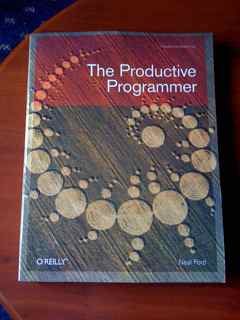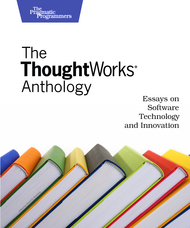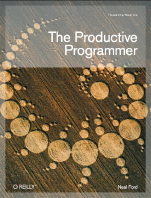I speak at lots of conferences in the US and Europe, and they pretty much have the same feel (modulo different languages, both programmer and spoken). But I also speak at a few conferences in emerging technology markets, like my recent conference appearance for JAX-Asia, a Java-centric conference that happens over the course of three days in Singapore, Kuala Lumpur, and Jakarta. Attendees at these conferences are very much like attendees at conferences elsewhere: slightly geeked out, interested in learning about new stuff, and inquisitive. They also exhibit a lot of enthusiasm: there aren't as many conferences there as here, so going to a conference is a bigger deal.
I have two observations from my recent trip. I first observed (with the help of my colleague, Erik Doernenburg) that all the conferences in Asia have lots of sponsorships. Generally, attendees pay very little (if anything) to attend the conference; most of the cost is offset by vendor sponsorships deals. But along with the booth in the exhibit area, vendors get one or more keynotes. Now, I don't want to completely denigrate vendor keynotes. I've seen a couple that had actual content, not just blatant marketing. But, for the most part, the mode in Asia seems to be outrageous over-the-top marketing, making them not so much keynotes as "marketing-notes". Because most of the attendees aren't yet jaded and cynical, they stick around for the marketing-note, succumbing to the danger that their marketing bullshit detector is not as well honed as ones in the US and Europe. They might actually believe what this vendor is saying about SOA -- what a frightening concept! To their credit, the conference also books in regular sessions that offset some of the damage caused by toxic marketing-notes. One of my talks at JAX-Asia was my Evolutionary SOA talk, which is pretty much the polar opposite of what most vendors say about SOA. One of the reasons I like speaking at out of the way conferences like JAX-Asia concerns around this very issue. I'm very interested in providing my (and ThoughtWorks) perspective on technology and methodology to offset the message of people just trying to sell something. I genuinely want to advance the state of software development, which has no geographic boundaries.
The second observation from JAX-Asia is the span of sophistication of the attendees. Just like any conference, you get a fair number of wide-eyed innocents, who just discovered Ant last week and want more cool stuff like that. To those attendees, preaching about dynamic languages and other cutting edge stuff is pointless: their primary interest in the conference is shoring up their current development practice, not spelunking into the future of technology. But it's a mistake to assume that all the attendees are beginners. Like any conference, a wide variety of skill sets and experience show up. For example, for JAX-Asia, I did a talk on JRuby, and another comparing Groovy & JRuby. JRuby was one thing: at least a few of the attendees had heard of Ruby. But the comparison talk was brutal on both me and my audience. No one had even heard of Groovy, so discussing the nuances of the differences between a technology represented by a word they had heard ("Ruby"), with another technology for which no one was familiar ("Groovy") was tough. Yet, generalizations are dangerous. After my talks in Jakarta, I was chatting with one of the attendees, who turns out to be the president of the Ruby users group in Jakarta, which has 50 members! To me, this shows two things. One, never assume that the crowd to which you are speaking in homogeneous. Even if the majority are novices, chances are good that there are some experienced developers there as well. And, two, Ruby has managed to penetrate pretty far and wide. A 50 person Ruby users group in Jakarta encourages me greatly because it shows that the foothold that dynamic languages have in the US and Europe is spreading to other parts of the world.
 One of the techniques I describe in
One of the techniques I describe in  Just a quick note to let my readers know that I'm speaking at the
Just a quick note to let my readers know that I'm speaking at the  Ever since I read Don Norman's
Ever since I read Don Norman's 

 Last year, one of the most refreshing conferences where I spoke was the Rich Web Experience. Too often, conferences are mono-cultures, and mono-cultures are generally boring. RWE is fundamentally different because it's what I call a condiment conference. The focus is on how to make applications better, not how to make the plumbing better. Nothing wrong with plumbing, mind you, it's just refreshing to look at faucets for a change.
Last year, one of the most refreshing conferences where I spoke was the Rich Web Experience. Too often, conferences are mono-cultures, and mono-cultures are generally boring. RWE is fundamentally different because it's what I call a condiment conference. The focus is on how to make applications better, not how to make the plumbing better. Nothing wrong with plumbing, mind you, it's just refreshing to look at faucets for a change.  OK, it's finally here. I got my copy of The Productive Programmer in the mail last week, and today Amazon updated it's status to "In stock". For all those who have been patiently awaiting this book, it's finally here. Finally! The first glimmer of this book started in 2005(!), so it's taken upwards of 3 years to convert what David Bock and I were talking about into actual tree-ware. Because it took so long to produce, I suggest that, if you are going to buy one, you should go ahead and buy 2, in case you lose one. And, of course, nothing says loving to your spouse like an O'Reilly book. A great gift for anniversaries, birthdays, bar mitzvah's, etc.
OK, it's finally here. I got my copy of The Productive Programmer in the mail last week, and today Amazon updated it's status to "In stock". For all those who have been patiently awaiting this book, it's finally here. Finally! The first glimmer of this book started in 2005(!), so it's taken upwards of 3 years to convert what David Bock and I were talking about into actual tree-ware. Because it took so long to produce, I suggest that, if you are going to buy one, you should go ahead and buy 2, in case you lose one. And, of course, nothing says loving to your spouse like an O'Reilly book. A great gift for anniversaries, birthdays, bar mitzvah's, etc. 
 My fifth observation is the dichotomy of their IT priorities. On the one hand, they've embraced SOA (particulary the bad parts, in my opinion) whole-heartedly. The important priorities for their enterprise development seems to be to lock down all variability (and therefore flexibility, evolvability, and adaptability) from their enterprises. They have state of the art SOA fetish there, building meta-SOA frameworks. Yet, you ask them about some of the things considered interesting in the states (like the rise of dynamic languages), it's not even on their radar. It's not that they have looked at it and disregarded it. They haven't even heard of most dynamic languages. Ruby? Groovy? Python? The only one they've even heard of is Perl, and they have a poisionous disdain for it. They have of course heard of JavaScript, but it's a toy language for visual effects in browsers. They treat it like an extension of CSS.
My fifth observation is the dichotomy of their IT priorities. On the one hand, they've embraced SOA (particulary the bad parts, in my opinion) whole-heartedly. The important priorities for their enterprise development seems to be to lock down all variability (and therefore flexibility, evolvability, and adaptability) from their enterprises. They have state of the art SOA fetish there, building meta-SOA frameworks. Yet, you ask them about some of the things considered interesting in the states (like the rise of dynamic languages), it's not even on their radar. It's not that they have looked at it and disregarded it. They haven't even heard of most dynamic languages. Ruby? Groovy? Python? The only one they've even heard of is Perl, and they have a poisionous disdain for it. They have of course heard of JavaScript, but it's a toy language for visual effects in browsers. They treat it like an extension of CSS.


 This isn't a book review because it's considered bad taste to review books in which you participate. But,
This isn't a book review because it's considered bad taste to review books in which you participate. But, 
 I'm speaking at the upcoming
I'm speaking at the upcoming  In the movie 2001, A Space Odyssey, the director Stanley Kubrick spends a vast amount of time with lava lamp-style special effects. The last part of the movie is an interminable journey through the same scene with different colors. Kubrick would never make that movie now: at least a third would end up on the cutting room floor. But he was entranced with the shiny new technology and indulged it to distraction.
In the movie 2001, A Space Odyssey, the director Stanley Kubrick spends a vast amount of time with lava lamp-style special effects. The last part of the movie is an interminable journey through the same scene with different colors. Kubrick would never make that movie now: at least a third would end up on the cutting room floor. But he was entranced with the shiny new technology and indulged it to distraction. While I've been "away", hammering away at my own book project (see
While I've been "away", hammering away at my own book project (see  No, I haven't fallen off the face of the earth. I haven't been blogging lately because I've been heads-down, finishing (finally!) The Productive Programmer. Understanding why it took so long requires some recent history.
No, I haven't fallen off the face of the earth. I haven't been blogging lately because I've been heads-down, finishing (finally!) The Productive Programmer. Understanding why it took so long requires some recent history. My wife Candy's cousin John Glasgow is missing. John was last seen leaving his Little Rock, AR home Monday morning around 5:30 am, January 28, 2008. A cell phone ping later that day indicated that he was in the vicinity of Petit Jean Mountain. His car was found unlocked the next day at the Mather lodge on Petit Jean with valuables still inside. He is believed to have been wearing a green Marmot down jacket and khaki pants at the time of his disappearance.
My wife Candy's cousin John Glasgow is missing. John was last seen leaving his Little Rock, AR home Monday morning around 5:30 am, January 28, 2008. A cell phone ping later that day indicated that he was in the vicinity of Petit Jean Mountain. His car was found unlocked the next day at the Mather lodge on Petit Jean with valuables still inside. He is believed to have been wearing a green Marmot down jacket and khaki pants at the time of his disappearance.

